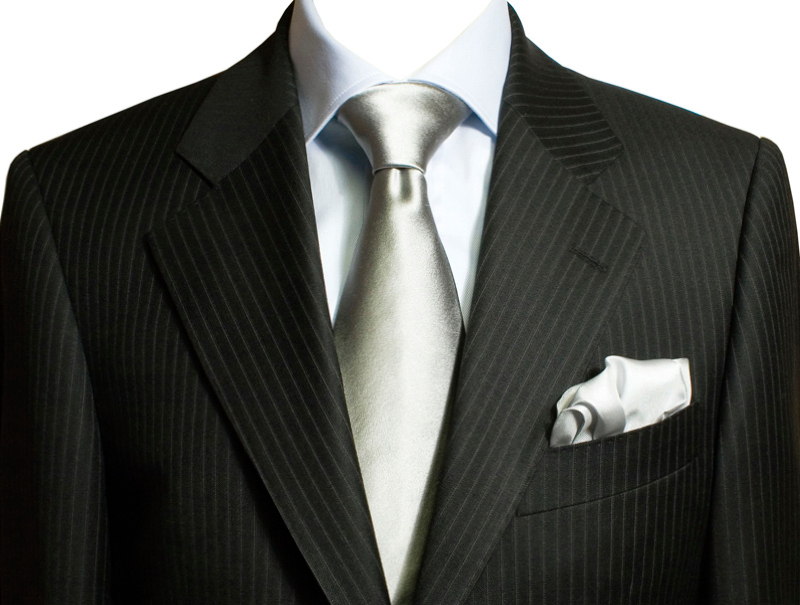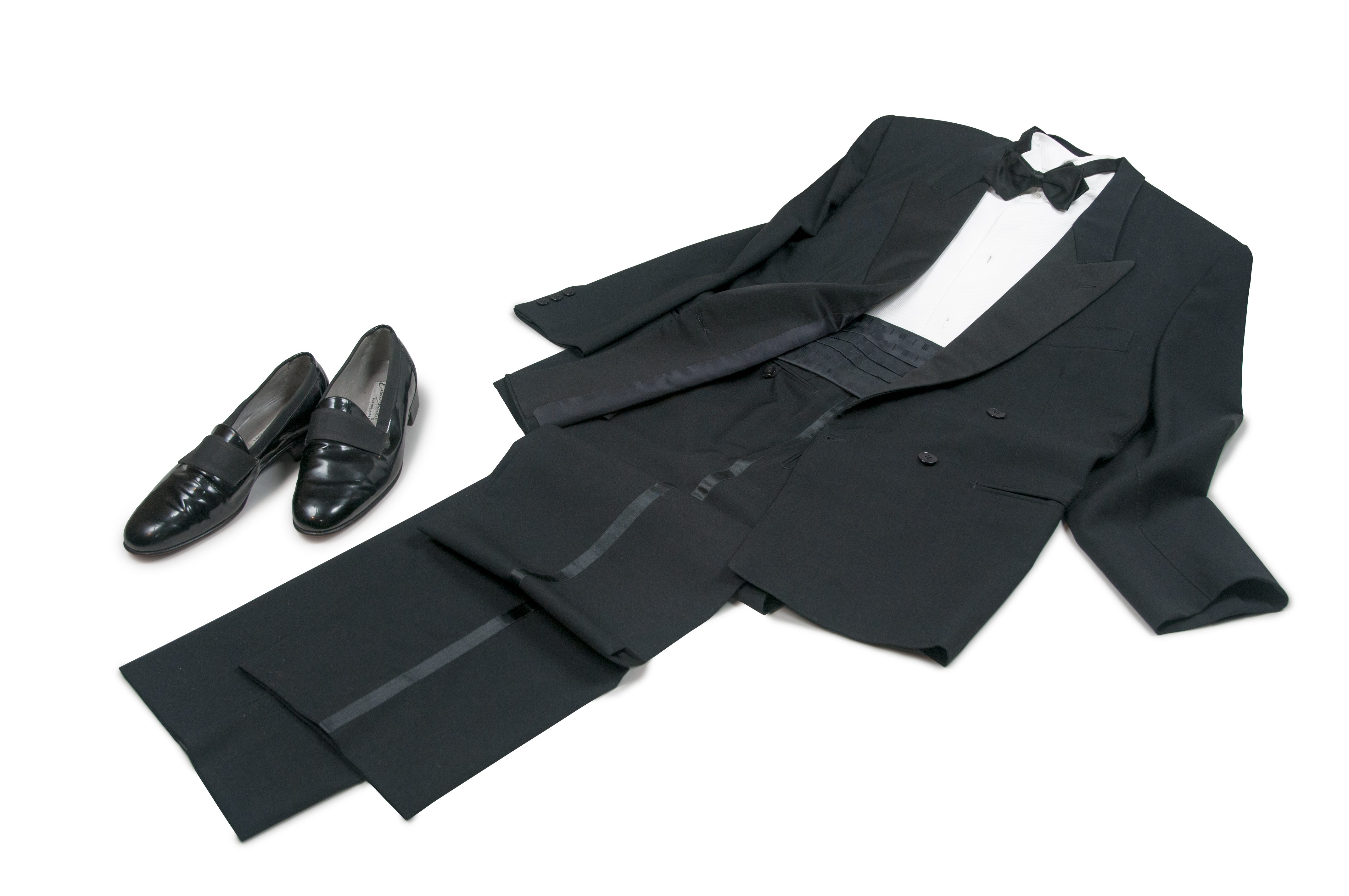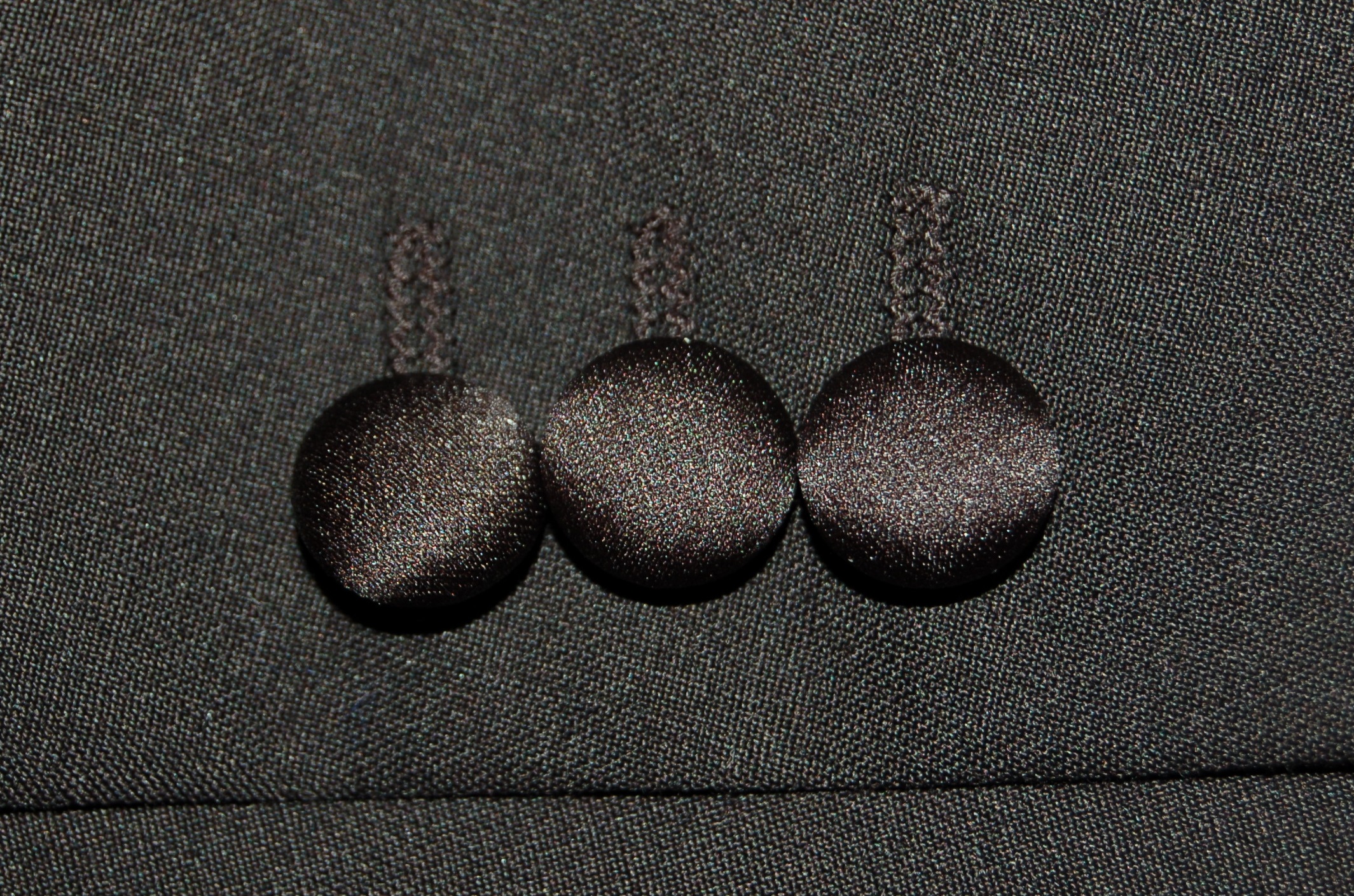|
Lapels
A lapel ( ) is a folded flap of cloth on the front of a jacket or coat below the collar. It is most commonly found on formal clothing and suit jackets. Usually it is formed by folding over the front edge of the jacket or coat and sewing it to the collar, an extra piece of fabric around the back of the neck. There are three basic forms of lapel: notched, peaked, and shawl. The notched lapel, the most common, is usually seen on business suits, and on more casual jackets like blazers and sport coats. The peaked lapel is more formal, and nearly always used on double-breasted jackets, but also frequently appears on single breasted ones.Flusser (2002). p. 85 The shawl lapel is usually carried by tuxedos and mess jackets.Antongiavanni (2006). p. 172 Types Notched The notched lapel (American English), step lapel or step collar (British English) is sewn to the collar at an angle, creating a step effect. This is the standard on single-breasted suits, and is used on nearly all suit ja ... [...More Info...] [...Related Items...] OR: [Wikipedia] [Google] [Baidu] |
Tuxedo
Black tie is a semi-formal Western dress code for evening events, originating in British and North American conventions for attire in the 19th century. In British English, the dress code is often referred to synecdochically by its principal element for men, the dinner suit or dinner jacket. In American English, the equivalent term tuxedo (or tux) is common. The dinner suit is a black, midnight blue or white two- or three-piece suit, distinguished by satin or grosgrain jacket lapels and similar stripes along the outseam of the trousers. It is worn with a white dress shirt with standing or turndown collar and link cuffs, a black bow tie, sometimes an evening waistcoat or a cummerbund, and black patent leather dress shoes or court pumps. Accessories may include a semi-formal homburg, bowler, or boater hat. In Britain, some individuals may rebel from the formal dress code by wearing coloured socks or a bow tie that is not black, such as red. For women, an evening g ... [...More Info...] [...Related Items...] OR: [Wikipedia] [Google] [Baidu] |
Dinner Jacket
Black tie is a semi-formal wear, semi-formal Western dress code for evening events, originating in British and North American conventions for clothing, attire in the 19th century. In British English, the dress code is often referred to synecdochically by its principal element for men, the dinner suit or dinner jacket. In American English, the equivalent term tuxedo (or tux) is common. The dinner suit is a black, midnight blue or white two- or three-piece Suit (clothing), suit, distinguished by satin or grosgrain jacket lapels and similar stripes along the seam (sewing), outseam of the trousers. It is worn with a white dress shirt with standing or turndown Collar (clothing), collar and link cuffs, a black bow tie, sometimes an evening waistcoat or a cummerbund, and black patent leather dress shoes or court pumps. Accessories may include a semi-formal Homburg (hat), homburg, bowler hat, bowler, or boater hat. In Britain, some individuals may rebel from the formal dress code by wear ... [...More Info...] [...Related Items...] OR: [Wikipedia] [Google] [Baidu] |
Suit
A suit, also called a lounge suit, business suit, dress suit, or formal suit, is a set of clothes comprising a suit jacket and trousers of identical textiles generally worn with a collared dress shirt, necktie, and dress shoes. A skirt suit is similar, but with a matching skirt instead of trousers. It is currently considered semi-formal wear or business wear in contemporary Western dress codes; however, when the suit was originally developed it was considered an informal or more casual option compared to the prevailing clothing standards of aristocrats and businessmen. The lounge suit originated in 19th-century Britain as sportswear and British country clothing, which is why it was seen as more casual than citywear at that time, with the roots of the suit coming from early modern Western Europe formal court or military clothes. After replacing the black frock coat in the early 20th century as regular daywear, a sober one-coloured suit became known as a lounge suit. ... [...More Info...] [...Related Items...] OR: [Wikipedia] [Google] [Baidu] |
Business Suit
A suit, also called a lounge suit, business suit, dress suit, or formal suit, is a set of clothes comprising a suit jacket and trousers of identical textiles generally worn with a collared dress shirt, necktie, and dress shoes. A skirt suit is similar, but with a matching skirt instead of trousers. It is currently considered semi-formal wear or business wear in contemporary Western dress codes; however, when the suit was originally developed it was considered an informal or more casual option compared to the prevailing clothing standards of aristocrats and businessmen. The lounge suit originated in 19th-century Britain as sportswear and British country clothing, which is why it was seen as more casual than citywear at that time, with the roots of the suit coming from early modern Western Europe formal court or military clothes. After replacing the black frock coat in the early 20th century as regular daywear, a sober one-coloured suit became known as a lounge suit. Suits ... [...More Info...] [...Related Items...] OR: [Wikipedia] [Google] [Baidu] |
Peak Lapel
A lapel ( ) is a folded flap of cloth on the front of a jacket or coat below the collar. It is most commonly found on formal clothing and suit jackets. Usually it is formed by folding over the front edge of the jacket or coat and sewing it to the collar, an extra piece of fabric around the back of the neck. There are three basic forms of lapel: notched, peaked, and shawl. The notched lapel, the most common, is usually seen on business suits, and on more casual jackets like blazers and sport coats. The peaked lapel is more formal, and nearly always used on double-breasted jackets, but also frequently appears on single breasted ones.Flusser (2002). p. 85 The shawl lapel is usually carried by tuxedos and mess jackets.Antongiavanni (2006). p. 172 Types Notched The notched lapel (American English), step lapel or step collar (British English) is sewn to the collar at an angle, creating a step effect. This is the standard on single-breasted suits, and is used on nearly all suit jac ... [...More Info...] [...Related Items...] OR: [Wikipedia] [Google] [Baidu] |
Single-breasted
A single-breasted garment is a coat, jacket, vest, or similar item having one column of buttons and a narrow overlap of fabric. In contrast, a double-breasted coat has a wider overlap and two parallel rows of buttons. Single-breasted suit jackets and blazers typically have two or three buttons (jackets with one or four buttons are less common), and a notch lapel. However, from the 1930s onwards, peaked lapels on a single button jacket have been variably in fashion. The width of the lapels is one of the most changeable aspects of the jacket, and narrow peak lapels on single-breasted jackets became popular during the 2000s. Historically, the single-breasted jacket was worn by the ground troops: it was easier to mount a horse with the fronts spreading out to the sides. The back of the jacket also had one slit for ease of dressage. Those who were especially enterprising even cut the floors in the front, and so appeared a modern tailcoat. Buttons on a single-breasted jacket cou ... [...More Info...] [...Related Items...] OR: [Wikipedia] [Google] [Baidu] |
Double-breasted
A double-breasted garment is a coat, jacket, waistcoat, or dress with wide, overlapping front flaps which has on its front two symmetrical columns of buttons; by contrast, a single-breasted item has a narrow overlap and only one column of buttons. Basic design and variations On most modern double-breasted coats, one column of buttons is decorative, while the other is functional. The other buttons, placed on the outside edge of the coat breast, allow the overlap to fasten ''reversibly'', left lapel over right lapel. To strengthen the fastening, a functional inner button, called the ''jigger'' (or ''anchor button''), is usually added to parallel-fasten the overlapped layers together from the inside. Double-breasted suit jackets, sports jackets and blazers typically have one to four rows of buttons (each row containing two buttons), one or two of the rows functional. Each fastening method is identified using "number-on-number" terminology; the first number is the total n ... [...More Info...] [...Related Items...] OR: [Wikipedia] [Google] [Baidu] |




